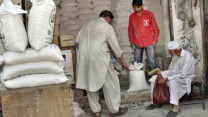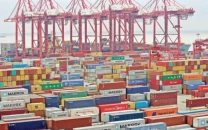Slowdown: Growth tapers off in FMCG sector as inflation eases, power crisis worsens
Sector’s ability to pass on price increases to consumers is a major growth driver.

Unilever Plc’s local subsidiary, Unilever Foods, recorded real growth rate of 10% during the first nine months of FY2012-2013. PHOTO: FILE
After posting impressive returns in the stock market during fiscal year (FY) 2011-2012, the fast moving consumer goods (FMCG) sector witnessed slower growth in the first nine-months of FY2012-2013, according to an independent analysis conducted by The Express Tribune.
The FMCG sector grew at an average rate of 18.8% between 2005 and 2011, according to data collected by the State Bank of Pakistan. In contrast, consumer goods companies listed on the Karachi Stock Exchange saw their top-line grow by a much lower 12.6% during the first nine months of FY2012-2013.
Similarly, ‘real’ growth in the FMCG sector declined to 4.26% during the first nine months of FY2012-2013, adjusted against an average inflation rate of 7.98% over the same period. This is lower than real growth of 5.8% achieved by the sector between 2005 and 2011, when the average inflation rate was in the double digits (12.27%).
While trends strongly indicate that the bulk of this growth was driven by price increases, a few companies have been able to show consistency in their growth trajectory.

Unilever Foods, for example, witnessed a real growth rate of over 10% during the first nine months of FY2012-2013 – much higher than the sector’s average real growth rate between 2005 and 2011. Similarly, Engro Foods achieved a real growth rate of 6.62% during the nine months of FY2012-2013, while National Foods’ real growth rate was 5.84% during the period, at par with the average real growth rate of the industry from 2005 to 2011.
“There is no denying the [standalone] potential of FMCGs, but it should be kept in mind that they have the ability to pass on the cost increases to consumers, sometimes by more than 100%,” Deputy Head of Research at AKD Securities Ayub Ansari told The Express Tribune in response to a question. “The FMCG sector has a superior pricing power, and this is one of the reasons why it is such a profitable sector,” he added.
The inflation rate has not changed much over the last 12 months, the consumer goods analyst said; that is one major reason why revenue growth in the FMCG industry has slowed down.
Ansari, however, was quick to point out that there are other factors as well that affect growth in the segment. Take the example of Engro Foods, the most sought-after consumer goods company in the FMCG sector. Its revenue growth for the quarter ending March, 2013 has slowed down, Ansari pointed out (Engro Foods grossed Rs9.62 billion in sales for the quarter ending March, 2013, down by 0.4% when compared with Rs9.66 billion it earned in the same quarter last year). This is, in part, due to the energy shortages in Punjab, which directly affected the company’s line of refrigerated products.
Admitting that high inflation is a factor driving growth in the segment, Ansari said other variables should also be kept in mind. “Population growth is one [such] variable – but that is something we have already been witnessing for the last 15 years. On the other hand, the ‘consumer boom’ is something that is particularly driving growth in the FMCG sector,” he said. “People are consuming more goods today as compared to the past,” he explained.
Published in The Express Tribune, June 11th, 2013.
Like Business on Facebook to stay informed and join in the conversation.



















COMMENTS
Comments are moderated and generally will be posted if they are on-topic and not abusive.
For more information, please see our Comments FAQ